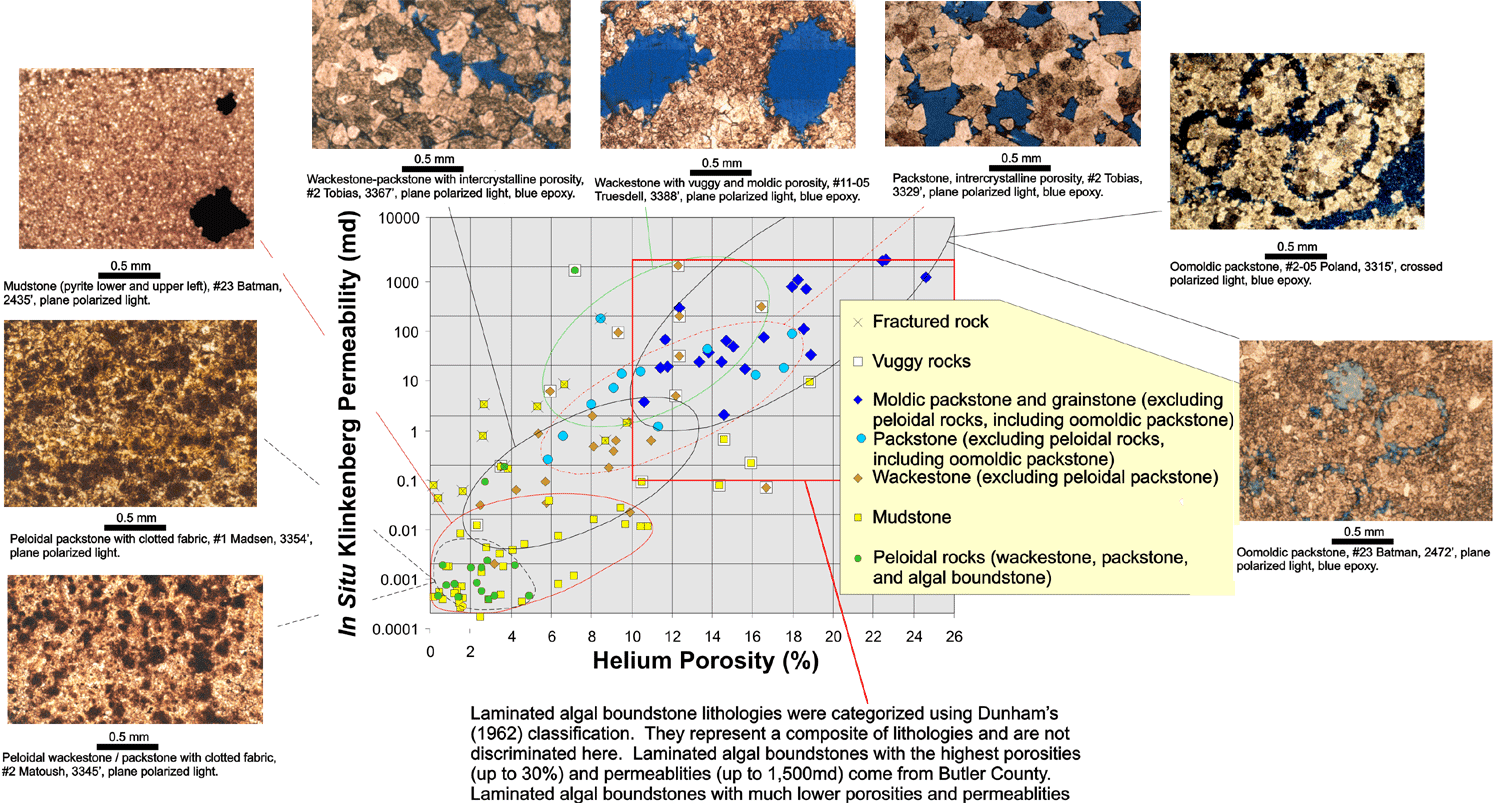
Arbuckle Reservoirs in Central Kansas: Relative Importance of Depositional Facies, Early Diagenesis and Unconformity Karst Processes on Reservoir Properties
Kansas Geological Survey
Open-file Report 98-55
Petrophysical properties of the facies at the core plug scale are generally controlled by matrix grain size. Each lithology exhibits a generally unique range of petrophysical properties modified by the presence of fractures, vuggy porosity, and grain size variation within the lithologic class. Facies comprising multiple lithologies of differing grain size exhibit different properties within those lithologies. Petrophysical properties for facies that are a composite of lithologies are scale-dependent and are a function of the proportions and architecture within the facies. All lithologies exhibit increasing permeability with increasing porosity and can be characterized as lying along the same general porosity-permeability trend. Variance in permeability for any given porosity is approximately two orders of magnitude and may be primarily attributed to the influence of such lithologic variables as the ratio and distribution of matrix and fenestral/vuggy porosity, grain size variations, and subtle mixing or interlamination of lithologies. Fracturing of lithologies enhances permeability but does not add significantly to porosity. Vuggy porosity appears to be isolated in mudstones but is better connected in wackestones. Vuggy pores can be well connected where vuggy porosity is extensive near the unconformity surface.
Extensive cementation within the peloidal packstone-grainstone matrix has resulted in nearly total occlusion of porosity and destruction of reservoir properties. Peloidal matrix porosities range from 0% to 4% and absolute permeabilities range from 0.0003md to 0.1md but are generally below 0.005md. Hydrocarbon column heights in Kansas are insufficient to desaturate the matrix and irreducible water saturations are near 100%. Fenestrae within this facies may range up to several centimeters in length and may enhance porosity by several percent. A single sample with fenestrae extending the length of the core plug indicates that permeabilities within these pores exceed 1,000 md. However, fenestrae in this lithology are not interconnected but are isolated by low permeability matrix.
Mudstones without fractures or fenestrae exhibit porosities ranging from zero to 10% and absolute permeabilities ranging from <0.0001md to 0.1md. Where fenestrae are present, porosity may be enhanced up to values as high as 17%, however, the fenestrae are primarily isolated and permeabilities are not increased significantly. If small fractures are present, porosity is not enhanced significantly, but permeability may increase to as high as 5md. Threshold capillary entry pressures for this lithology are sufficiently high that hydrocarbons have not entered the matrix pore space though they may be present in the minor fracture pore volume.
Wackestones without vugs exhibit porosities ranging from 2% to 11% and permeabilities ranging from 0.01md to 1md. Where vugs are present, porosities can range from 9% to 17% and permeabilities can range from 1md to 1,000 md. Packstone porosities range from 6%, for finer-grained rock and where packstone is mottled with wackestone, to 18% for cleaner more coarse-grained rock. Permeabilities in the packstone lithology range from 0.1md to 50md. Packstones contain little to no vuggy porosity but exhibit intercrystalline and moldic porosities ranging from 11% to 30%, associated permeabilities range from 10md to 1,500md. The highest porosity and permeability values are exhibited by clean, homogeneous, medium-grained moldic packstones. Boundstones do not represent a major lithology in the cores studied but a single sample exhibited a porosity of 32% and a permeability of 1,500md.

|
|
e-mail : webadmin@kgs.ku.edu
Last updated November 2002
http://www.kgs.ku.edu/PRS/Poster/1998/98-55/P3-02.html